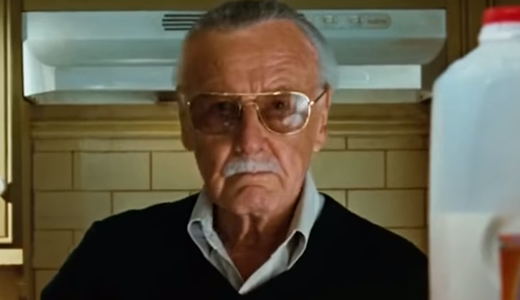As you’ve probably heard by now, Stan Lee died yesterday at the age of 95. Many have eulogized Lee as a “comics legend,” and that’s wholly fair. As a writer, editor, publisher and eventually chairman of Marvel Comics, he created or co-created some of the world’s most famous superheroes and helped redefine the genre itself. (I wrote a little about that here.) But his influence well surpasses the world of comics. In fact, he’s one of the prime architects of pop culture itself.
Born Stanley Martin Lieber, Lee at first wanted to write the next Great American Novel. But first, he needed a job. He found one in 1939 at Timely Comics, which would ultimately become Marvel.
Producing comic books wasn’t exactly a glamorous industry at the time, and Lee’s work there wasn’t glamorous, either. “In those days [the artists] dipped the pen in ink, [so] I had to make sure the inkwells were filled,” he told the Los Angeles Times in 2009. “I went down and got them their lunch, I did proofreading.” He wrote his first story in Captain America Comics in 1941, titled “Captain America Foils the Traitor’s Revenge.” (It marked the first time he ever called himself Stan Lee, too.)
But Lee wouldn’t truly make his mark until the 1960s. Rival DC Comics had successfully launched the Silver Age of Comic Books by introducing Martian Manhunter and reimagining old Golden Age heroes such as Green Lantern and the Flash. Marvel wanted in on that action, and they turned to Lee to get it. Lee promptly teamed with Jack Kirby to create the Fantastic Four, and the two would go on to collaborate on some of superherodom’s most enduring heroes. Most of the Avengers we know today—Iron Man, Hulk, Black Panther and Thor, for starters—were created by Lee and Kirby. Lee paired with Steve Ditko to make Spider-Man and Doctor Strange. He and Bill Everett cobbled together Daredevil.
Moreover, Lee helped make these superheroes a little more human—more down-to-earth, if you will. And that helped broaden the characters’ appeal. Wrote comic historian Peter Sanderson:
Marvel was pioneering new methods of comics storytelling and characterization, addressing more serious themes, and in the process keeping and attracting readers in their teens and beyond. Moreover, among this new generation of readers were people who wanted to write or draw comics themselves, within the new style that Marvel had pioneered, and push the creative envelope still further.
All that would’ve been legacy enough, of course. But the Marvel that Lee created wasn’t done yet—not by a longshot. In some ways, it hadn’t really even started yet. Soon, these superheroes began branching out into different forms of media and entertainment. As a kid, I loved watching Spider-Man on The Electric Company. As I got older, I bought a Spider-Man “web spinner” with my very own money. (My mom took it away from me after I got hard-to-clean-up webbing on our China hutch). I tuned into a short-lived Spider-Man television show. As a bill-paying adult, I rode The Amazing Adventures of Spider-Man ride at Universal Studios in Orlando, Florida.
For years, Spider-Man was the behemoth that drove Marvel’s outside entertainment ventures. And arguably, it was 2002’s Spider-Man movie that launched the superhero movie genre that dominates cinema today.
At the time of Spider-Man’s release, most of the rest of Marvel’s stable of superheroes was little known outside the world of comics. Sure, Hulk had some fans and the X-Men were reasonably popular, but Iron Man? Hardly anyone had heard of this Lee creation until 2008, when Marvel—sick of handing its creations to other studios to mangle and make money off of—released a little flick that starred Robert Downey Jr. as the titular superhero. More than $300 million later, the Marvel Cinematic Universe was off and running.
Lee continued to play a part in that cinematic universe—quite literally. His cameos became beloved little Easter eggs for each new installment.
And the movies themselves … well, just look at the box office: Black Panther and Avengers: Infinity War—both stuffed with Lee creations—land at No. 1 and No. 2 this year in North America. (If you count overseas money, the order flips, with Infinity War at No. 1.) Four more superhero movies (Incredibles 2; Deadpool 2; Ant-Man and the Wasp; Venom) land in the top 10, inheritors of Lee’s groundbreaking legacy—just this year alone. Overall, Disney’s Marvel Studios have made $18 billion in the last 10 years, powered largely by Lee’s superheroes: (That’s twice what the Star Wars franchise has made over the same time frame, incidentally.) Add in the Marvel movies made by other studios, and Marvel’s been responsible for $30 billion in worldwide earnings at the box office.
And that doesn’t count the money made by the various iterations made for television or video games. Or all the toys and toothbrushes sold with Spider-Man or Thor on them. Or, of course, the comics themselves, which is still a billion dollar industry.
For years, Lee was a little ashamed of his work. He wanted to write the Great American Novel, after all. But, according to a statement on Marvel’s site, he eventually came to another conclusion:
And then I began to realize: entertainment is one of the most important things in people’s lives. Without it, they might go off the deep end. I feel that if you’re able to entertain, you’re doing a good thing.
The impact Lee has had on our lives is far greater than he would’ve had had he settled in to write the Great American Novel. He’s one of the prime architects of pop culture, really. We live in Stan Lee’s world.






Recent Comments